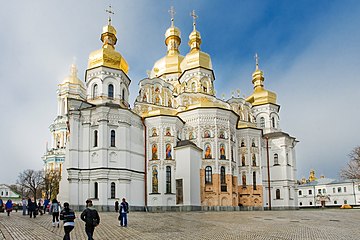By Nadia Schwarz
In the Kiev Caves Monastery, the center of Orthodox life since 1051, whose religious, historical and cultural value is impossible to assess, they are currently preparing to “save in the West” the relics of saints, icons and other objects of incalculable value for the Russian people.
Ukraine explains this decision with the Russian nuclear threat, which some experts interpret as a provocation planned by the United States to carry out a nuclear strike and blame it on Russia. Other analysts, for example, Rostislav Ischenko, believe that the possible provocations in Kiev or other Ukrainian regions and the removal of the treasures from the Cave Monastery are two parallel operations that only coincide in space-time. This view is reinforced by the fact that “saving” the relics is evidently the result of preparations made in advance, for which the control of the monastery was forcibly and urgently transferred from the Ukrainian Orthodox Church (with jurisdiction in the Moscow Patriarchate and which has explicitly supported Putin’s policy) to the Ukrainian Orthodox Church, led by Epiphanius, the Metropolitan of Kiev and all Ukraine.
Rostislav Ischenko, historian, political science expert, former Ukrainian diplomat, now a citizen of Russia, has the following view of the matter: “Cultural values are taken out of Ukraine for three reasons. First, the Americans (and it is precisely they who are the organizers of the operation, even if they receive the treasures from their European partners) never considered the future existence of Ukraine as an independent state. Therefore, the West is taking what was left under its control, just as the Germans did in 1943-44, the French in 1812, the Poles in 1611-12. The key word for the West is “valuable” and once they get their hands on it, valuable objects are no longer easily let go.” Recall the Machu Picchu artifacts smuggled out of Peru and barely returned by the Yale Museum a century later, the huge Egyptian collections in British museums and those of all indigenous cultures – from Mexico to Magellan – in North American museums.
“Second, the West is trying to make up in part for what it has spent in Ukraine. It is crystal clear that they will never be able to get money from Kiev. But it opens up the possibility of negotiating with Russia afterwards. The relics of Ilya Muromez (Elijah of the city of Murom is a legendary warrior, defender of Rus, who later took the habits, lived in the caves where his incorrupt relics remain until now, canonized a saint in 1643) and other local saints, for Western politicians are nothing more than mere mummies. But they know that for Russian Orthodox Christians these relics have an eschatological (perennial) value that cannot be measured with money. After the war is over, they might try to exchange these treasures for hard cash.”
“Third and foremost, the West traditionally removes (or plunders?) valuable artifacts from dominated peoples for display in its museums just as the Roman Empire filled the Pantheon with the gods of conquered lands. It is a sort of material testimony of historical-cultural domination by the West, its role as self-proclaimed leader of world civilization… The idea of superiority and domination over “backward peoples” is molded from childhood, through these collections in museums, among other things. Seeing such trophies a young Westerner unconsciously assures himself that it is the West that civilized the Russians and therefore “has the right” to instruct and correct his misguided pupils.”
Then the well-known analyst raises the question why the Ukrainian elites, so patriotic and believing, do not oppose but support the transfer of multiple, almost millennial and priceless objects. He answers: “Icons and relics, Scythian gold and Bulgakov’s works, the Cave Monastery and the monument to the Grand Prince St. Vladimir, the Christianizer of Russia (who began his political career as the prince of Novgorod in the north of Russia) in the hills of Kiev, all this reminds us of the common roots of our peoples… because we have the same faith, the same history and the same traditions”.
The collections of the Kiev museums, the icons and relics of the saints summon the historical memory of the descendants of the great ancestors and for some of them they can reach very deep. For many, they are sacred objects. But brought to the West, distributed in a thousand museums, without showing much interest because they are part of the history of others, these objects cease to be dangerous and become painted tablets, mummies, texts written in an unknown language, pieces of gold. Ilya Muromez, captured by the West, does not represent a danger, no one will ask why someone born and raised in the Russian city of Murom is lying peacefully in the monastery of Kiev, who this warrior served in the territory that is now Ukrainian, why these cities were part of the same state. Perhaps they were the same people? Perhaps the great-great-grandchildren of the ancient inhabitants of Murom and Kiev are still one and the same people?”
“In other words, the West in its favorite style, exchanges beads and mirrors not only for gold and ivory but for the soul of the people, for their everlasting values that are replaced by the “European values” that they themselves have invented,” Rostislav Ischenko ends by telling us in his analysis.






